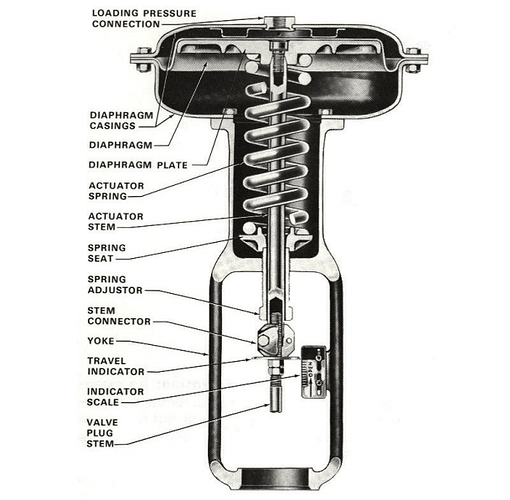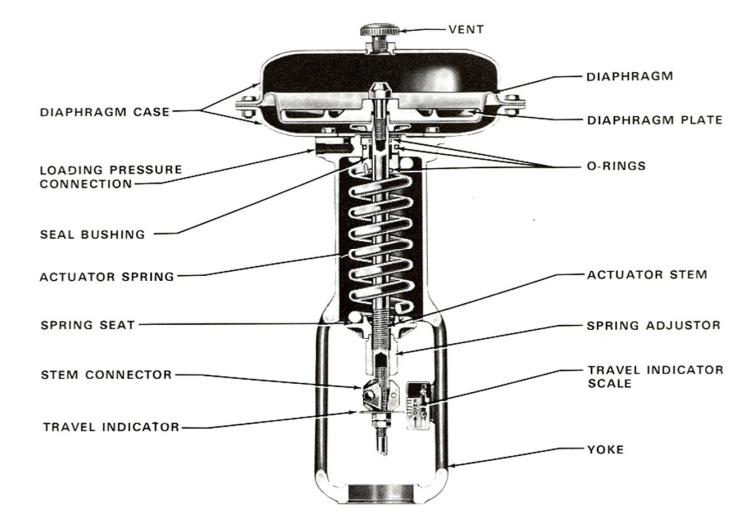Most common control valve actuators are pneumatically operated but other means of operation such as electric, hydraulic and manual actuators are also available.
Control Valve Actuators
The operation mechanism of an actuator can be direct acting (Figure 1) or reverse acting (Figure 2). The spring and diaphragm pneumatic actuator is most popular due to its dependability and simplicity of design.
Pneumatically operated piston actuators provide integral positioner capability and high stem force output for demanding service conditions.
Adaptations of both spring and diaphragm and pneumatic piston actuators are available for direct installation on rotary shaft control valves.
Figure 1: Direct acting diaphragm actuator
Figure 2: Reverse-acting diaphragm actuator
Read:
The choice between direct acting and reverse acting pneumatic controls depends on what position the valve should back to in the event of failure of the compressed air supply.
This choice depends upon the environment of the application and safety requirements. It makes sense for steam valves to close on air failure, and cooling valves to open on air failure.
Table 1: Effect of the choice valve and actuator action for single port valves
Electric and electro-hydraulic actuators are more complex and more expensive than pneumatic actuators. This is due to these types of actuators offer advantages where no air supply source is available, where low ambient temperatures could freeze condensed water in pneumatic supply lines, or where unusually large stem forces are needed.
A brief summary regarding the design and characteristics of the actuators are given as follows.
Diaphragm Actuators
Pneumatically operated, using low-pressure air supply from controller, positioner, or other source.
Various styles include:
Direct acting - increasing air pressure pushes down diaphragm and extends actuator stem;
Reverse acting - increasing air pressure pushes up diaphragm and retracts actuator stem;
Reversible - some small sized actuators can be assembled for either direct or reverse action ;
Direct acting unit for rotary valves - increasing air pressure pushes down on diaphragm, which may either open or close the valve, depending on orientation of the actuator lever on the valve shaft.
Net output thrust of diaphragm actuators is the difference between diaphragm force and opposing spring force. Molded diaphragms are used to provide linear performance and increased travels. Size is dictated by output thrust required and supply air pressure available. It is simple, dependable, and economical.
Piston Actuators
Pneumatically operated using high pressure plant air to 150 pisg, often eliminating the need for supply pressure regulator. Furnish maximum thrust output and fast response. It is easily reversible by changing action of the integral valve positioner. Best designs are double acting to give maximum force in both directions.
Various accessories can be incorporated to position the actuator piston in the event of supply pressure failure. These include spring return units, pneumatic trip valves and lock up systems.
Also available are hydraulic snubbers, handwheels, and units without yokes, which can be used to operate butterfly valves, louvers, and similar industrial equipment.
Other versions for service on rotary shaft control valves include a sliding seal in the lower end of the cylinder. This permits the actuator stem to move laterally as well as up and down without leakage of cylinder pressure.
(This feature permits direct connection of the actuator stem to the actuator lever mounted on the rotary valve shaft, thereby eliminating much of the lost motion common to jointed leakage.)
Electro Hydraulic Actuators
Requiring only electrical power to the motor and an electrical input signal from the controller. It is ideal for isolated locations where pneumatic supply pressure is not available but where precise control of valve plug position is needed.
Units are normally reversible by making minor adjustments and are usually self-contained, including motor, pump, and double-acting hydraulically operated piston within a weatherproof or explosion proof casing.
Manual Actuators
Manual actuators is useful where automatic control is not required, but where ease of operation and good throttling control is still necessary.
It is often used to actuate the bypass valve in a three-valve bypass loop around control valves for manual control of the process during maintenance or shutdown of the automatic system.
It is available in various sizes for both globe style valves and rotary shaft valves. It is dial indicating devices available for some models to permit accurate repositioning of the valve plug or disc and much less expensive than automatic actuators.
Read:
- Different Valve Types
- Types of Check Valves
- Introduction to Valves
- Control Valve Trim
- Parts of Control Valves
credits: kolmetz


